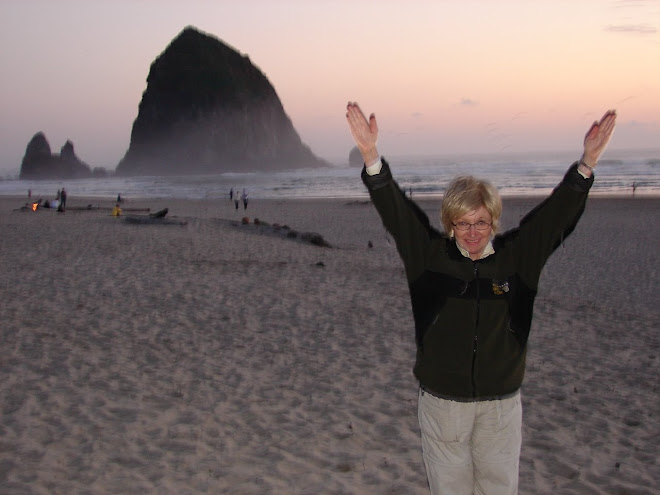Several hours before the drama starts down on the amphitheater stage, a different kind of drama---call it "culinary drama" is unfolding with the food service staff at this satellite branch of the world-famous "Big Texan Steak Ranch" of Amarillo, Texas. (You know the one I'm talking about----famous on the Travel Channel show for filming folks who dare to take the challenge of eating a 72 oz. steak, with the promise of getting the meal "free" if you can do it.) There are no contests at the Palo Duro Canyon site, but before you even make it to the entrance gates of the Pioneer Amphitheater, the enticing aromas of grilled steak make you glad you purchased the optional supper meal that is served before the performance begins. As a Registered Dietitian, I was especially pleased to see the gigantic bowl of salad greens at the start of the buffet line, followed closely by tiers of fresh fruit---green and purple grapes, plus juicy red watermelon slices (lower left photo). There were also several starchy dishes to choose from, fresh rolls, as well as grilled jalapeno peppers, and a big, sizzling, grilled steak of beef to chow down on. Add your choice of several kinds of beverages, and you have a meal fit for a real cowboy (or a hungry automobile driver in my case--lower right photo). Diners have their choice of eating on picnic tables under a shaded pavilion, or out in the open, on tables painted with the familiar state flag of Texas design (top right photo). The hospitality staff, all dressed in western attire, are easily lassoed into bringing you beverage refills or assisting in other ways as needed (top left photo).

Another optional choice for your evening in Pioneer Amphitheater is a back-stage tour. The tour I took was led by Allison Tindall (lower left photo). Like many other employees there, she is a student at West Texas A & M University, where she is majoring in theatre performance. By taking the tour, guests are able to see the back side of the rotating backgrounds that frame the main stage (upper left photo), the costumes (middle right photo) and a view of the amphitheater seats before any guests are seated (middle left photo). Another activity one can do before the show is not only listen to, but dance along, to the sounds of a great-sounding live band that performs up until showtime. Several guests joined in to dance when the band played that Texas party song "Cotton-eyed Joe" (top two photos), as well as the ever-popular "Chicken Dance" tune.
When the band stops playing, guests know it is time to find their seats in the amphitheater, and wait for the start of the show. The show starts with a very dramatic appearance---600 feet above the stage---of a real cowboy on a real horse carrying a really big Texas state flag. The sun is just starting to go down, and provides a dramatic back light to silhouette the scene along the canyon rim. (Middle left photo).The horseback rider then gallops across the top of the canyon until he disappears beyond eyesight . At that point, the action down on the stage begins with singing, dancing, more horses galloping right behind the stage, and then right up onto the stage (lower left photo). The drama that then unfolds is described this way by Texas Governor Rick Perry, whose photo and letter greet you on the first page of the official program: "A production as grand and spectacular as the beautiful canyon in which it is performed, "Texas" celebrates those courageous men and women who settled our rugged frontier. This story reminds us of the hardships our forebears faced and emboldens us to continue to blaze trails for the generations to come." The governor's admonition for us to remember those early residents of the canyon is similar to David's acknowledgement in Psalms 77:11 "I will remember the deeds of the Lord; yes, I will remember your miracles of long ago." Unless we can be mindful of all the struggles that have enabled us to be where we are, we will not have the "attitude of gratitude" for our many blessings in this great country.
As darkness engulfs the outdoor stage, various sections of the canyon walls are lit up, along with a bath of light illuminating the performers on stage (upper left photo). There are special effects that include a lightning strike, igniting a tree behind the stage, a wagon catching on fire, as well as the cowboy with the wagon (I was assured no one is injured for these stunts, and members of the local fire department are always present for any emergencies that might occur.) And, for sure, do not leave early from the amphitheater, in hopes of beating the traffic out. That's because, there is a terrific fireworks show at the end of every performance that you will not want to miss! (three remaining photos). I say "HATS OFF!" (Cowboy hats, of course!) to the cast, crew, cowboys and cowgirls that make up the Texas Panhandle Heritage Foundation---the main producers of the drama. Happy Trails to you, until we meet again! Tricia 

























